Chapter 21: 16th century. Art in Italy
1/13
There's no tags or description
Looks like no tags are added yet.
Name | Mastery | Learn | Test | Matching | Spaced |
|---|
No study sessions yet.
14 Terms
Leonardo da Vinci MONA LISA
c. 1503-1506. Oil on wood panel, 30-1/4" × 21" (77 × 53 cm).
Musée du Louvre, Paris.
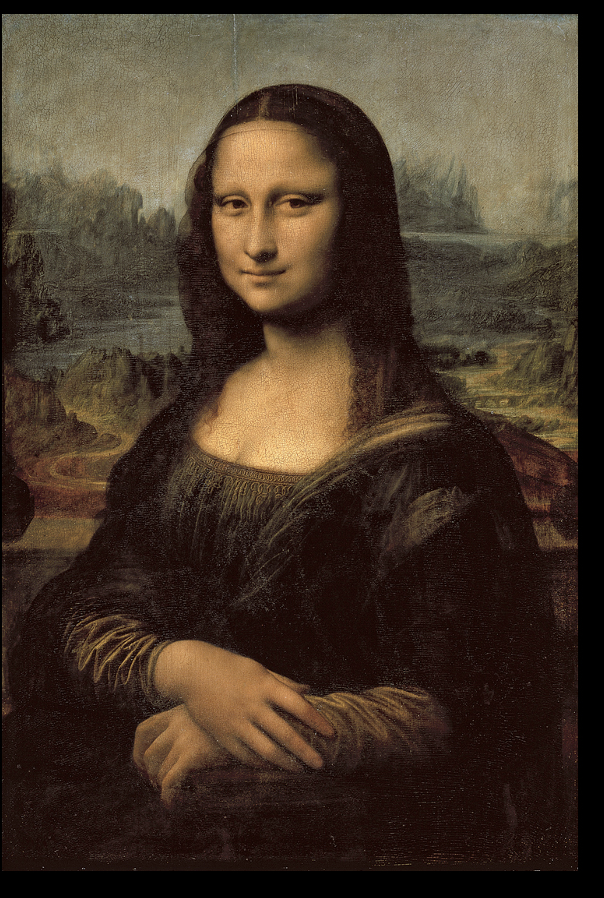
Port
portrays Antonio Maria gherardini the wife of Francesco del Giocondo
-leonardo abandone long standing tradition of wealthy women
-Pyramidal form of half lenght figure, sfumato
Mona is a term of respect meaning lady
-enigmatic expression
-naturalistic description and classicizing idealism
-clarity and balance structure of the pyramidal composition to give utter stability of human form
-likeness of a specific woman,
hides her personality, lacks warmth , psychological complexity
Reformation
High renaissance
1480-520
Sense of gravity and decorum
complex but ordered relationship of inividual parts to the whole
emulation of the principle artist saw in ancient classical art
real an ideal
Oil painting era and private commissions fro private sources
3 main artis:Michealangelo, Leonardo,Raffael
Leonardo da Vinci THE VIRGIN OF THE ROCKS
c. 1485. Oil on wood panel (now transferred to canvas),
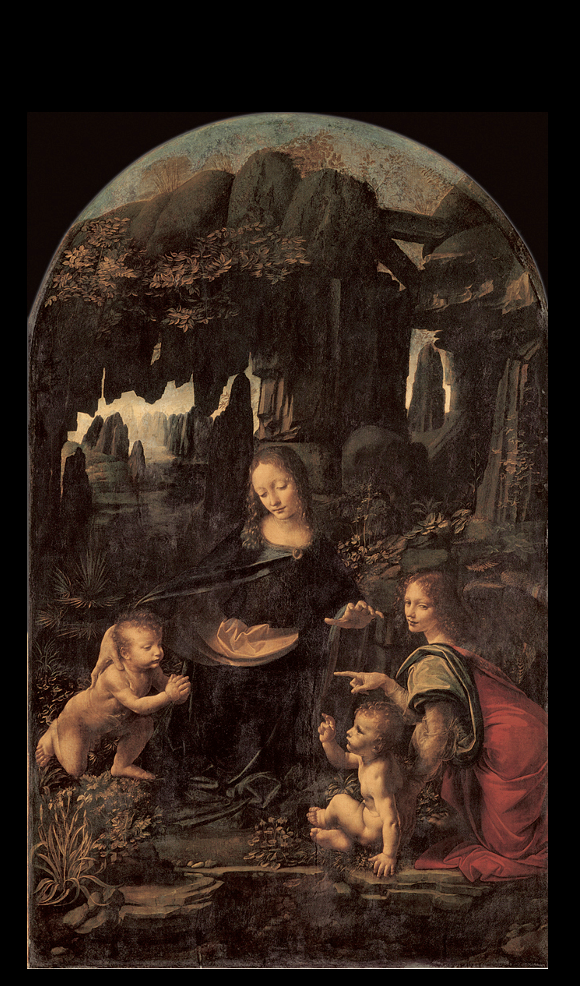
sfumato= technique of making a smoke effect, a landmark of leonardo’s style
Chiaroscuro=light versus dark, enhancing forms
Lots of composition
Pyramidal figural groupe composition
he also painted the last supper
Who invented the Vitruvian man
Leonardo da vinci
-ideal man is 8 heads high
Raphael AGNELO DONI AND MADDALENA STROZZI
c. 1506. Oil on wood panel, each 24-1/2" × 17-1/4" (63 × 45 cm).
Palazzo Pitti, Florence. [Fig. 21-08a]
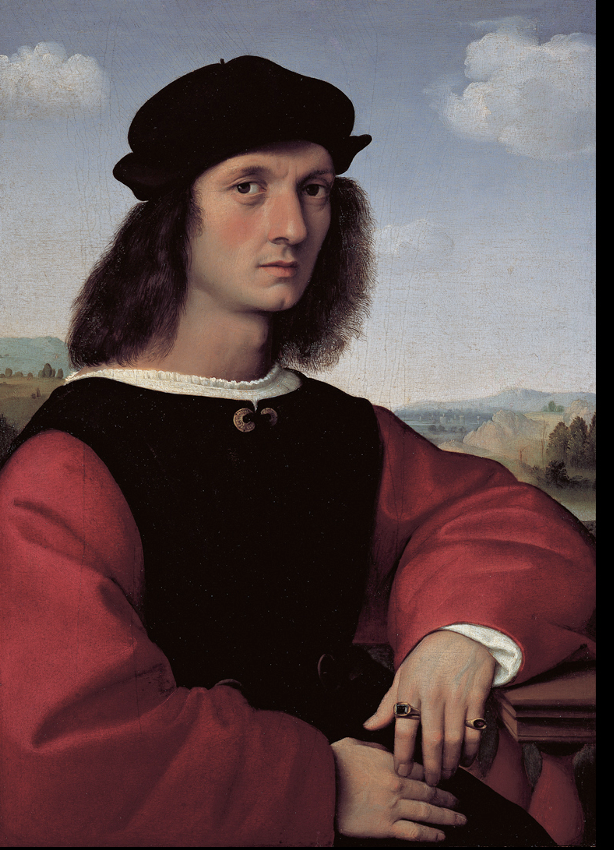
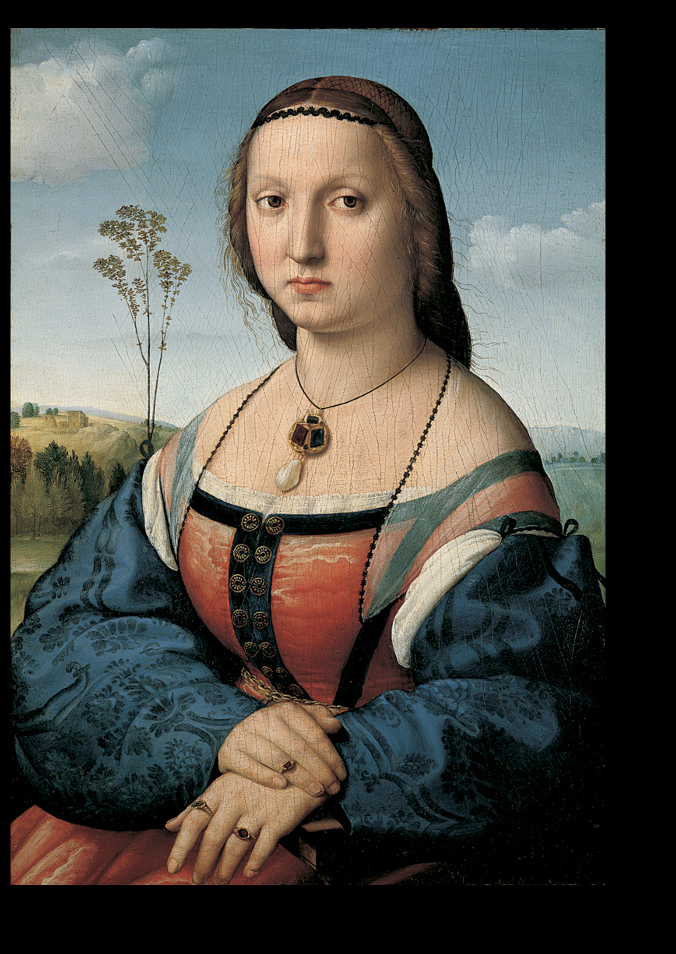
pendant portrait
aress subjects to viewers
A CLOSER LOOK: The School of Athens
by Raphael, fresco in the Stanza della Segnatura, Vatican, Rome.
c. 1510-1511. 19' × 27' (5.79 × 8.24 m).
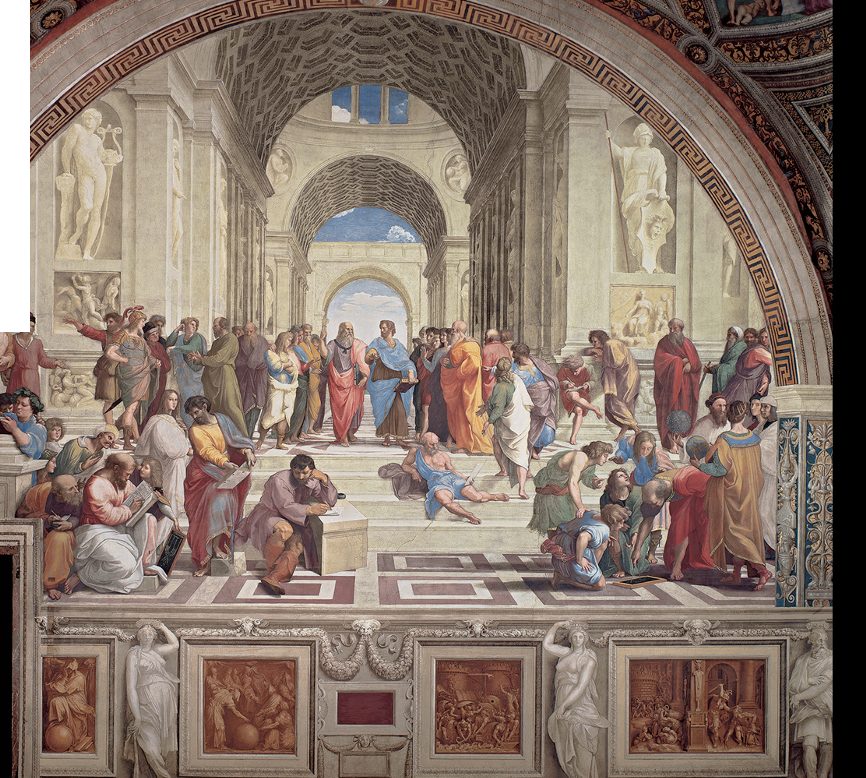
pope julius II put Raphael t work decorating rooms in the papal apartments
Stanza della segnatura the popes private library and study
He painted 4 branches of knowledge: religion, philosophy, poetry, law
one of the most influential in papal rooms
summarizes ideals of the renaissance papacy in hormoniously arranged form in rational space, as well as the calm dignity of figuresthat occupy it
Julius approved the figures
Center stage: Plato and Aristotle, right and left of vanishing point, against sky an under barrel vaults
Around plato and Aristotle are mathematicians, naturalist, astronomers, geographers, and philosophers whom are demonstrating theories.
Scene in interior with clear light from a single source inspired from St-peters new design
Grandeur of building is matched from philosopher who all have physical and intellectual presence. Arcs are activated from energy of poses an gestures creating dynamic unity representing High renaissance art
A closer look:
-Sculptures of Apollo(god) and Minerva(goddess) on niches of wall, looking down
-Plato points up as if were at the center of philosophy, Aristotle gesture toward his surounding symbolizing empirical world
-Euclid bent ver slate, caims that he resembles Bramate an architect of st-peters
-Raphaelportrait cam be found with Ptolemy(geographer) holding globe, and Zoroaste(astronomer) hloding celestial globe
-Figure of Heraclitus is a portrait of Michealangelo who was working on the sistine chapel, has stone cutter boots to be seen as a sculptor
-Diogenes Cynic as socrates or cup shows his raught of hemlock and position show his teachings from prison
-Figures around Euclid shows stages of understanding
Raphael praised for ability to communicate clearly through poses a expressions
Michelangelo PIETÀ
c. 1500. Marble,
St. Peter's, Vatican, Rome.
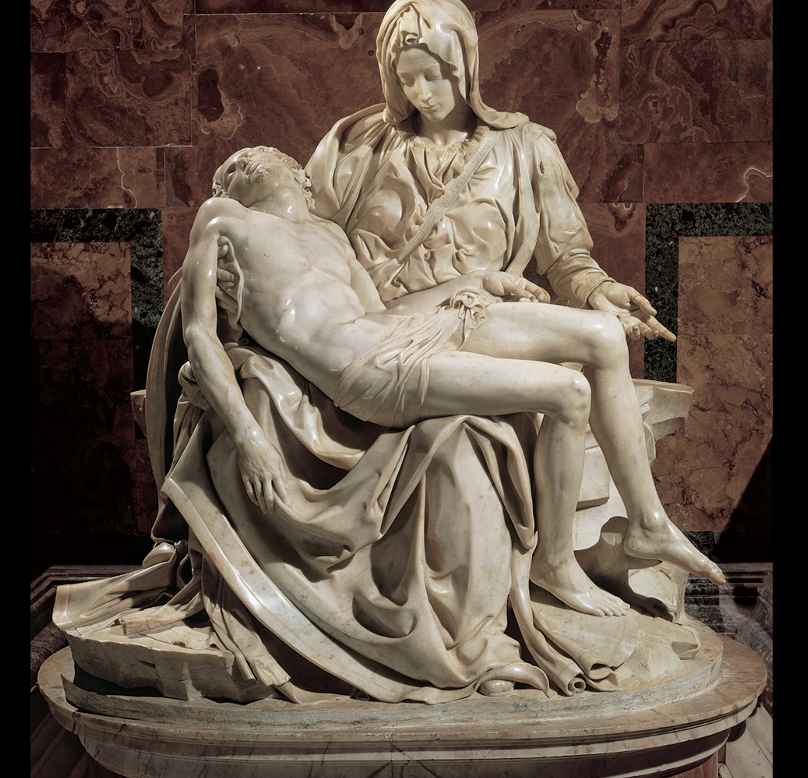

-Michelangelo apprentice of Chirlandaio where he studies fresco and classical monuments
-He joined household of Lorenzo the Magnificient
-his early work at the turn of the century commissioned by by a french cardinal and placed as a tomb monument in Old st peters
-Theme of Pieta(Virgin mourns Jesus in lap) popular in northern Europe was unusual in Italy at the time.
-He travelled to marble quarries at Carrara to select blocks for his work, known for all his sculptors
-Choice of stone was important because he envisioned his sculptor as already exsisting within the marble, needing tools to set it free
-he was a poet writing in his sonnet about sculpting
-The Virgin is a heroic woman of stature holding smaller lifeless body of son
-Inconsistence of scale and age are forgotten
-Compelling vision of beauty meant to be seen up close at Jesus’s face
-he apparently snucked in at night signing the stutue at virgin’s breast
INTERIOR, SISTINE CHAPEL
Vatican, Rome. Built 1475-1481; ceiling painted 1508-1512; end wall, 1536-1541.
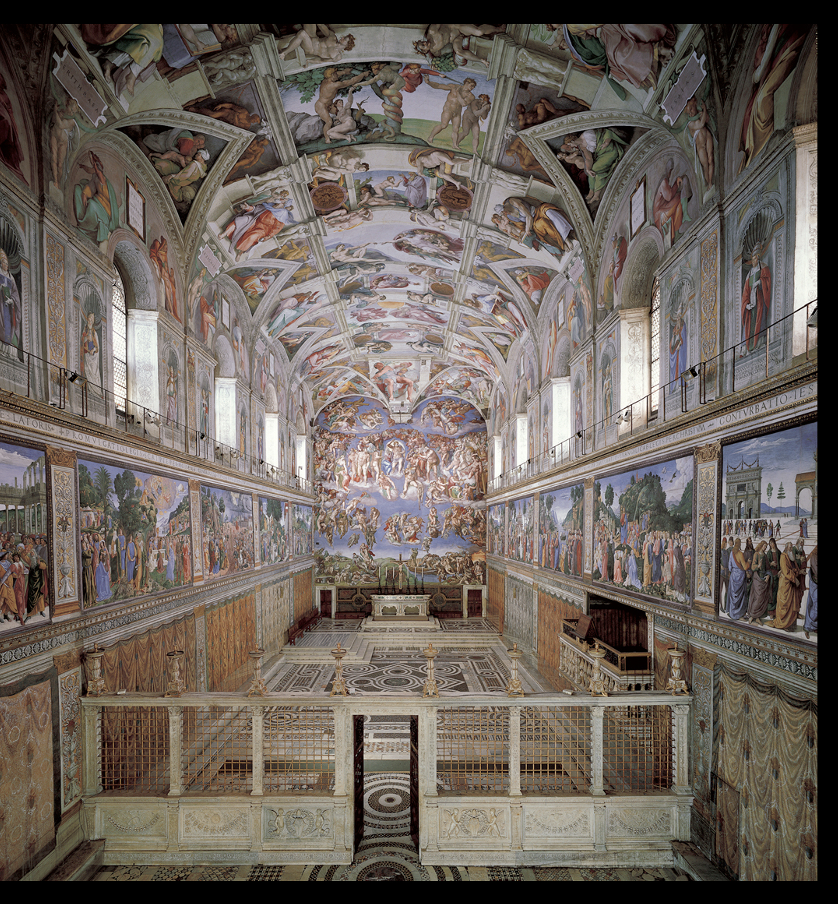
Pope Julius II ask michealangelo to come paint in rome to work on tomb for himself
Began tomb but 2 years later started on sistine chapel
He was a sculptor and complained about painting the chapel and created a new powerful style in Renaissance painting
First order for a simple trompe l’oeil then later wanted 12 apostles seated in thrones on the triangular spandrels between lunettes framing windows
appenrently objected and then was told to paint whatever he liked and so he did guided by theological advisor of the pope
An illusionistic marble architecture establishe frameowrk of the vault
around the ceiling is a painted cornice with projections supported by pilasters decorated with “sculptured”putti
Between pilasters are prophets and sibyls who have fortold Jesus’s birth
Seated on fictive cornice are ignudi holding sashes attached to gold medallion
Behind ignudi are shallow bands of fictive stone at center of ceiling and divide it into 9 compartments contaning scenes from Genesis(creation, fall, flood) starting over alter til near end of chapel entrance.
Gos earliest creation are closest to altar, Eve followed by imperfect acts of humanity: Temptation, fall, expulsion fro paradise, a=gods eventual destruction besides Noah and family and flood.
8 triangular spandrel over windows and lunettes crowing them containing painting of ancestor of Jesus
Creation of Adam:go charged the languorous adam, in a pose fro roman rover god type, with the sparks of life. Adam’s heroic arm stretches out mirroring god’s
Eve below god’s arm in energetic manner looking at Adam
• was a creative explosion
•Developemt of evolution and can speak to many pople
•three stages: 1. Reflect perpociaol perspective2. after columbus 3. age of discovery under way and the church wanted to go global
•Reflected Jewish and Christian people
•Florentine art
•Micheal angelo wasn;t really a painter , he was an essentialess,
•hE WAS SO COMMKTED GOT IT DONE IN 3 ½ YEARS REACHIG ABPVE HIS HEAD TO PAINT
•Space, structure, energy
•More driven by structural form than colour
•He didn’t focus on the studd being creative but on the act of creation
•were on momet from contact between adam and god and eve is under god’s arm still a key item
•heart of the ceiling is creation of women
•Past meet present of Jonah, leaning into our own space
•arch wall is last judgment:
•he painted destvy to leave alegacy of excellence
Vison of human unity(black and white man)
people who can battle diversity
•He showed inner strength as external power
•complaint about nudity from other
•Forces us to look around as if it’s a mirror , who am i?

What is poesis?
“painted poetry” introduced by Giorgione, a enigmatic pastoral theme
ex: The temptest
Titian "VENUS" OF URBINO
c. 1538. Oil on canvas,
Galleria degli Uffizi, Florence.
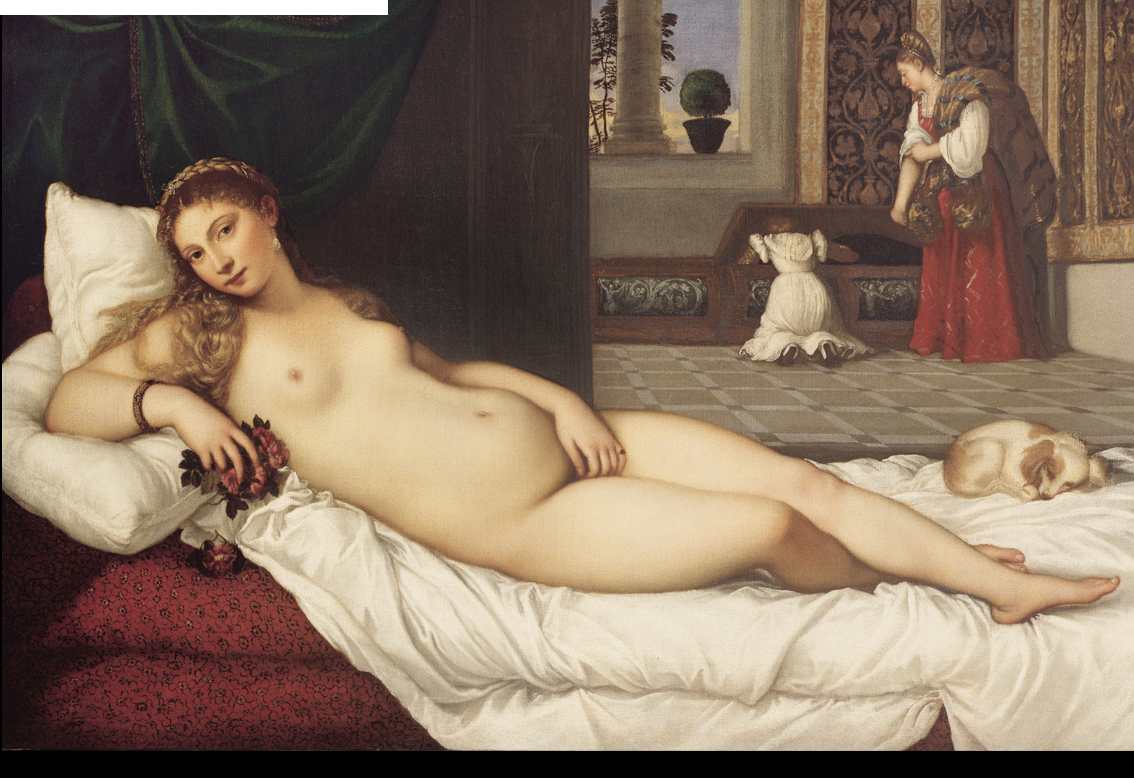

-nude reclining woman became popular in court circles, where men could appreciate the “Venus” under the cloak of respectable mythology
-Titian delivered to Guidobaldo della Rovere in 1538
-In venetian courtesan with provacative gestures, strecthing over couch in a spacious palace,
-Glowing hair and flesh set off by white pillow and sheets
Rona Goffen argued it was more about marriage than mythology than seductiveness
-Multiple matrimonial references include: pair of cassoni where servants are storing clothes in the back. bridal symbolizes of the myrtle and roses she holds, spanial snoozing at feet(symbol of fidelity and domesticity, especially when sleeping peacefully).
—Picture may be associate with duke Guidobalo’s marriage in 1524 to the 10 year old Giulia Verano. 4 years later when the picture arrive she would be considered a adult more than a child bride
-bride welcoming her husband into the lavish bedroom
what is Mannerism and give an example
-develope in florence rome 1520’s and associated with the death of Raphael-maniera means stlye
•This style developed into an anti-Classical movement in which artificiality, grace, and elegance took priority over lifelike references.
•Patrons favored esoteric subjects for its own sake
•Painters and sculptors quoted other works with self-conscious playfulness.
•Architects used Classical orders in unconventional ways, defied uniformity and balance
-contrived composition and irrational spatial environment
-figures have elongated proportions,enigmatic gestures, dreamy, expressions, complicate artificial poses
Parmigianino MADONNA OF THE LONG NECK
1534-1540. Oil on wood panel,
Galleria degli Uffizi, Florence.
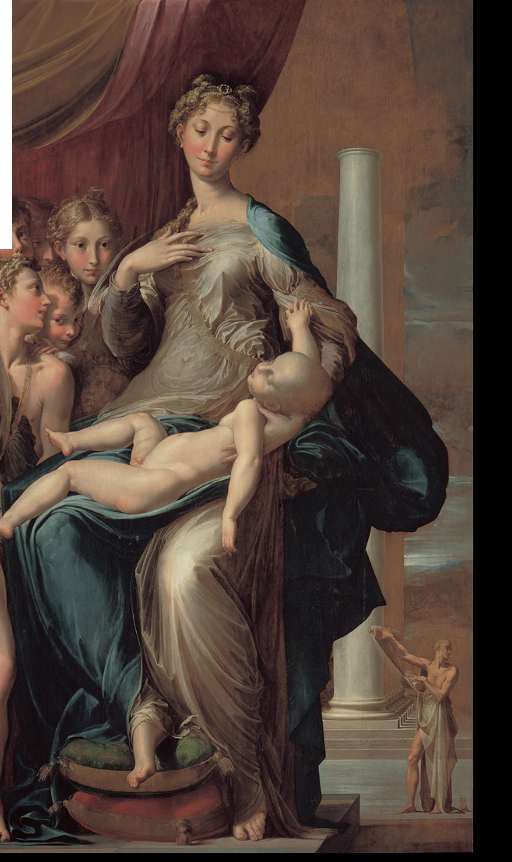
left unfinished of his early death
unatural porprotion of mary,massive legs lower torse, narrow shoulders,long neck and fingers.Seated on throne but throne in sight
sleeping child recalls pose of ashen in a pieta
resembles Michelangeo sculpture at Vatican, like diagonal band across virgin’s chest
small jerome, unrolls scroll infront of column of an unfinished temple
left blushing boys block background
presented as a well known image in a challenging manner to intrigue viewers
Bronzino ALLEGORY WITH VENUS AND CUPID
Mid 1540s. Oil on panel,
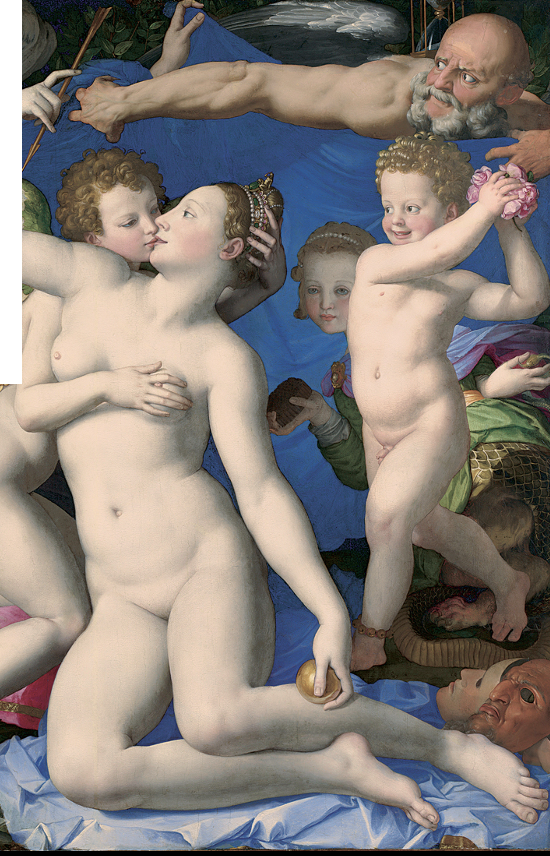
expression of bodies and flesh at expense of anatomically correct
formal ,iconographical, and psychological of mannerist art and could almost stand alone as a summary of the movement
exaggerated poses, graceful forms, polished surfaces, delicate colours that characterize Mannerist art
disturbing erotic attachment and bizarre irregularities
nothing is quite like it seems
Folly, Jest, Playfullness
multiple meaning
Michelangelo LAST JUDGMENT, SISTINE CHAPEL
1536-1541.
Fresco, Rome an the Vatican
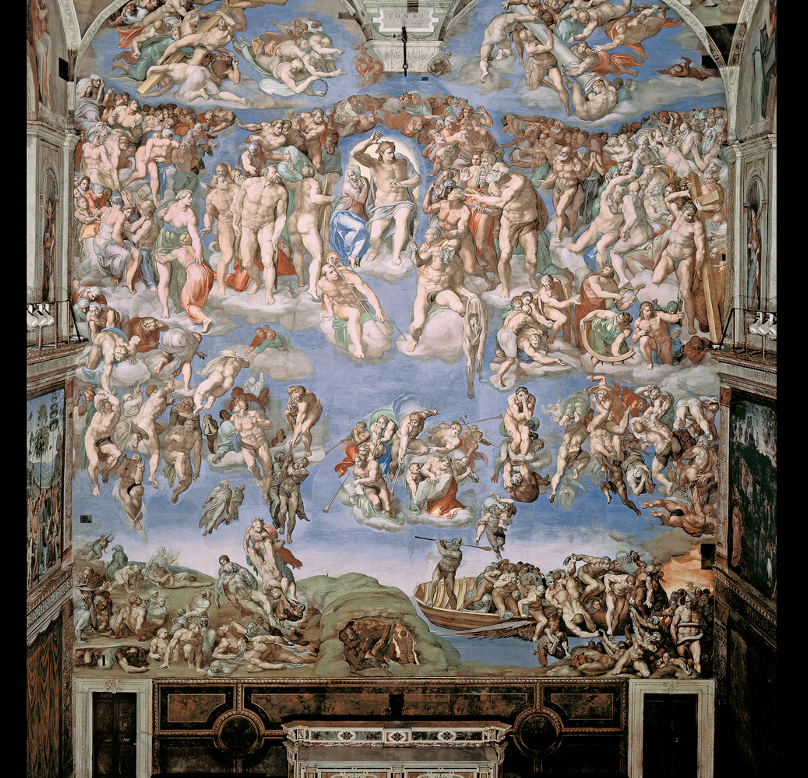
fresco
Paul 3 rebuilding the Capitoline Hill and continue work on St-Petrs to restore the heart of Rome
Commission work of some of the finest work of the late Italien renaissance
brought michelangelo back after 25 years to work of the sistine chapel
In his early 60’s felt old but still took the challenge of the last judgemet on 48 ft high end wall above the sistine chapel altar
A writhing swarm of resurrected humanity
left: dead are dragged from graves and pushed into vortex of figures around christ whom weild his arm life a sword of justice
shrinking virgin under christ arm represents change from gothic tradition where she’s enthrones beside and equal in size to him
right of christ feet is St. Bartholomew who was martyred by being skinned live. He holds his flayed skin, and micheal painted his own dissorted features on the skin
angels try to save Damned which plunges to hell on right, the elect and unjudged in a dazed state
lowest level of mural is gaping, fiery entrance of hell which Charon the ferry man propels his craft
inteprete as grimand constant reminder to celebrants of the mass(pope and his cardinlas) that they would also face stern judgement at the edn of time
Conservative clergy criticized for nudity and after michel death asked for drapery to be added by Daniele da Volterra which he got the name”breeches painter”